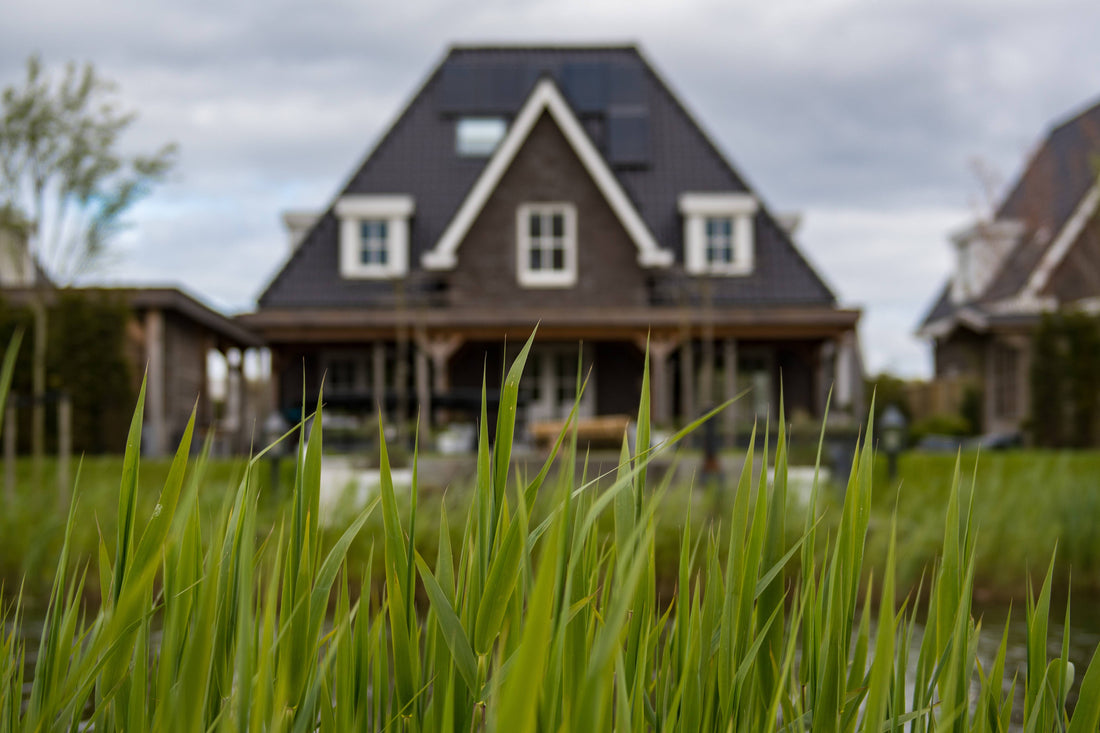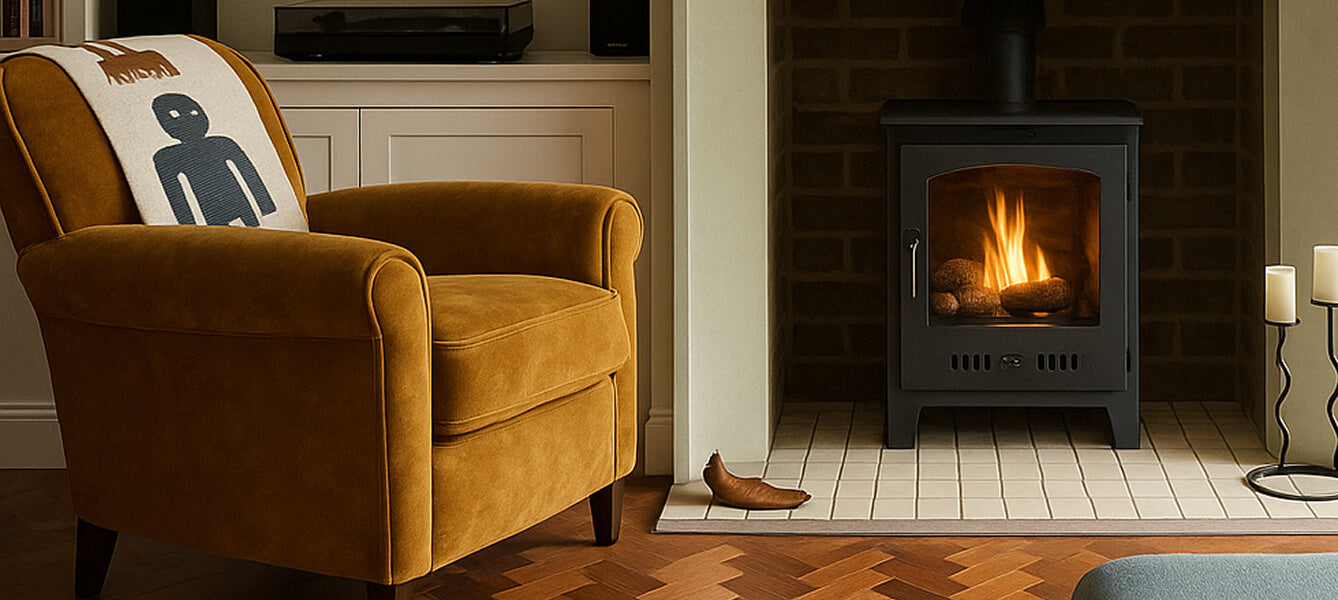
8 Eco-Friendly House Design Ideas: Build a Sustainable Home
We all want a beautiful place to live, but can we do it in a way that doesn't cost the earth? If you're considering how to design an eco-friendly home, you've come to the right place for eco-friendly ideas that look great and help minimise your carbon footprint.
In this article, we'll explore how to design an eco-friendly home, examining everything from saving energy and reducing your carbon emissions to the materials you use to furnish and decorate.
Whether you’re designing an environmentally-friendly house from scratch or looking for ways to decrease your carbon footprint in your existing home, we’ll show you how to protect the planet (and your bank balance).
Ready? Let's get saving the planet!

1. Passivhaus
Passivhaus might sound like a 90s techno band, but it's actually a recognised standard for home construction and design. Passivhaus standards aim to minimise the need for complementary space heating by using sunlight and human- and appliance-generated heat.
Shockingly, home heating accounts for 40% of the UK's energy consumption, while 85% of UK homes still use fossil fuels, such as natural gas. In fact, 14% of the UK's overall greenhouse emissions are produced as a result of energy burnt within our homes.
And while the UK is making great strides in the move towards carbon-beating renewable energies, the standard UK home continues to produce dangerously high amounts of carbon.
Passivhaus design dictates the shape, size, and physical orientation of a dwelling by optimising the amount of sunlight that heats the building. It dictates eco-friendly ways to generate and retain warmth, using effective ventilation and heat recovery from the ground.
Space heating should demand less than 15kWh per square metre to meet the Passivhaus standard. This is achieved through super-efficient insulation, accurate design, and a mechanical ventilation system for high-efficiency heat recovery.
Not only does a Passivhaus home create a minimal carbon footprint, but it will save you money on heating in the long run. And when energy costs are going through the roof, we should all be considering the efficiency of our heating systems.
So, if you're designing a new home, ask your architect about Passivhaus standards.
2. Use sustainable materials
Home construction is a significant contributor to global warming, using much of the world's natural resources while creating large amounts of pollution, waste, methane, and carbon dioxide. In fact, around 10% of the UK's carbon emissions can be directly attributed to construction activities, according to the UK Green Building Council.
So, it's essential to move away from building materials that strip the land of its resources - namely steel, concrete, aluminium, and plastics.

Instead, use sustainable materials, such as:
- Sustainably sourced wood
- Lime
- Straw bales (for insulation)
- Bamboo
- Cork
- Bioethanol instead of wood burning
- Reclaimed materials, such as wood and recycled plastic and steel
- Sheep’s wool
- Ashcrete or hempcrete
Of course, some of these materials are more expensive to source, but consider the money-saving insulation and fuel efficiency they provide over the lifetime of the building.
3. Draft-proof your existing home
One of the most practical efforts we can all make for more eco-friendly homes is to draught-proof. Insulating your existing home needn't cost a huge sum of money, especially when you consider how much you can save in the long-term.
Think about:
Loft insulation
The average semi-detached home costs in the region of £300 to insulate, but it can save you around £750 on your bills over five years.
Make even more of an impact by using eco-friendly insulation products. For example, SupaLoft Insulation Quilt is made from recycled plastic bottles. And Thermafleece CosyWool is made from sheep's wool, which is a sustainable product providing both heat and sound insulation.
Wall insulation
One-third of the heat lost through your home seeps through your walls. Most modern homes have cavity walls, which offers some insulation, but it can be improved with additional cavity insulation.
But you might live in a charming Victorian home with solid walls. In this case, fix insulating sheets to the insides of your exterior walls.

It's also possible to fit solid wall insulation to the outsides of your walls - accompanied by additional cladding, which can look really smart.
Draft-proofing your windows
Double glazed windows are the best way to insulate a room, dramatically improving fuel efficiency. However, not everyone wants sealed-unit glazing - it doesn't always fit the house's look, especially for period properties in conservation areas.
Secondary double-glazing is the answer for most period properties, maintaining the external aesthetic of the building while providing seal units inside the home. It's also possible to convert existing sash windows, although this can be expensive.
4. Upgrading your boiler
Although we're gradually moving away from fossil fuels, that's still a good twenty years away. In the meantime, one of the most eco-friendly things you can do to protect the environment is to upgrade your old gas boiler.
Not only will you save yourself some cash on your gas bills, but you'll also help cut down your home's carbon footprint.
The most popular low-carbon heating systems are:
- Storage heaters - using low-cost nighttime electricity to heat your home. Modern storage heaters are much more fuel-efficient than their old-fashioned counterparts.
- Air-source heat pumps - absorbing warmth from the outside to heat your home and water.
- Solar thermal panels - yes, even in the UK, we can heat our water and homes from the sun. And it’s possible to integrate solar panels into your roof tiles, so it won’t affect the look of your home.
- Eco-boilers - these are boiler systems that meet A-rated consumption standards. Most modern gas boilers fit into this category.
5. Swap your wooden log burner
Sure, log burners are one of the most attractive ways to warm a room, but they can be particularly harmful to the environment. While modern log burners are now designed with increased fuel efficiency in mind, they still pollute the air, which - in cities - can be particularly problematic.
But there's no need to dispense altogether with that lovely real flame - just switch away from wood-burning and move onto bioethanol.
Bioethanol is an alcohol produced as a by-product of high-sugar/starch crops. It's produced by fermenting the waste products of corn and sugarcane - considered a renewable energy source because it's made from products that would otherwise be thrown away.
Bioethanol fireplaces can heat your home with a real flame, but - essentially - without the environmentally harmful emissions. In fact, you don't even need a chimney or flue.
However, bioethanol fires produce less heat than an open fire. They create a heat output of around 3kWh - equivalent to an electric fire on medium heat. But, this can be an advantage, as wood-burning stoves are often too hot for most living rooms. So if you’re looking for a decorative solution to give you a lovely secondary source of heat, a biofire could be for you.
6. Water management
Most of us take our water supply for granted, but - actually - water is a precious resource that should be conserved. Sure, water falls out of the sky in pretty generous measures in the UK, but the storage, cleaning, and delivery of water into our homes comes at a high environmental cost.
So, if you’re designing an eco-friendly house, you should consider incorporating water-saving measures.
Think about water recycling systems and low-flush plumbing. Consider installing a rainwater harvesting system that can store up to 6500 litres of rainwater for washing your clothes and flushing the loo - saving you around 40% on your annual water consumption.
Check out SaveWaterSaveMoney.co.uk for more information.
7. Use low-impact paints and decorating materials
There are many environmental hazards around the home - the paint you use to decorate your walls is one of them.
VOCs are Volatile Organic Compounds and are present in oil-based products such as old-school gloss paints. When VOCs react with sunlight, they contribute to poor air conditions, such as smog.
Most modern paints are manufactured to low-VOC standards - these are water-based, producing low-to-no emissions. Look for the Low-VOC label on the paint tin.
However, VOCs aren't just found in paints. They're also present in carpet and vinyl flooring, as well as upholstery and foam and some composite wood products.
So when designing your eco-friendly home, consider the environmental impact of the products you decorate and furnish with.
8. Go to A+++ appliances
We fill our homes with appliances that make life a little easier, such as fridges, ovens, microwaves, dishwashers, washing machines, TVs and entertainment systems. And, let's face it, most modern homes are crammed with appliances that are either always on or aren't offering fuel efficiency.

Some easy changes you can make to improve your fuel efficiency:
- Convert your lighting to highly efficient LEDs
- Purchase white goods based on their A+++ rating
- Don’t leave appliances such as TVs on standby - it uses almost as much electricity
Modern appliances offer relatively low standby energy consumption - but they still use SOME power. A modern appliance should use 1-Watt or less per hour while on standby. That might not sound like a lot of power, perhaps, but, it adds up. After 1000 hours, that appliance uses 1kWh; over a year, that's 8.76kWh.
And an older TV is more likely to use around 12-Watts per hour on standby. That adds up to 106kWh over a year - and it's sitting there doing nothing!
So, when you're designing your eco-friendly home, make sure you check the energy consumption of the standby mode of your appliances. Because the planet isn't going to save itself!
Turn to bioethanol rather than fossil fuels with ImaginFires
ImaginFires offers a unique range of bioethanol fireplaces, with styles to suit every room.
From traditional log-burner-style fireplaces to funky, modern fireplace inserts, choose a fireplace that uses carbon-neutral bioethanol rather than fossil fuels that pollute the planet.

And because bioethanol produces no emissions, there’s no need for a flue or chimney.
Check out our range of beautiful bioethanol fireplaces. If you have any questions, just ask. We’d love to hear from you - we’re here to help.
